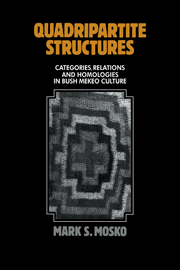Book contents
- Frontmatter
- Contents
- List of figures, tables, and maps
- Preface
- 1 Introduction: the problem and the people
- 2 Between village and bush
- 3 Body and cosmos
- 4 Sex, procreation, and menstruation
- 5 Male and female
- 6 Kin, clan, and connubium
- 7 Feasts of death (i): de-conception and re-conception
- 8 Feasts of death (ii): the sons of Akaisa
- 9 Tikopia and the Trobriands
- 10 Conclusions: indigenous categories, cultural wholes, and historical process
- Appendixes
- Notes
- Bibliography
- Index
6 - Kin, clan, and connubium
Published online by Cambridge University Press: 04 August 2010
- Frontmatter
- Contents
- List of figures, tables, and maps
- Preface
- 1 Introduction: the problem and the people
- 2 Between village and bush
- 3 Body and cosmos
- 4 Sex, procreation, and menstruation
- 5 Male and female
- 6 Kin, clan, and connubium
- 7 Feasts of death (i): de-conception and re-conception
- 8 Feasts of death (ii): the sons of Akaisa
- 9 Tikopia and the Trobriands
- 10 Conclusions: indigenous categories, cultural wholes, and historical process
- Appendixes
- Notes
- Bibliography
- Index
Summary
Based upon his reading of Seligmann's Mekeo ethnography, Lévi-Strauss observes:
The plan of their social organization is a subtle and complex symmetry, and the historical vicissitudes to which its componenet elements have been exposed have never succeeded in abating its strictness.
(1969b:77)Although there are differences between Bush and Central Mekeo social organization chiefly as a consequence of differences in scale, the “plan” in each case is, I think, virtually the same. The avowed purpose of this chapter is to elucidate as explicitly and simply as possible this subtle and complex symmetry that structures Bush Mekeo social relationships. To achieve this end, I relate the various categories of Bush Mekeo social classification to one another and to other contexts of the culture (Leach 1976; Schneider 1972, 1980; cf. Lounsbury 1965). I begin by describing and interrelating the set of kin categories in the indigenous language, the various idealized levels of unilineal clan fragmentation and residence, and the formalized interclan affinal relationships. Then I trace the logical interplay between these conceived cultural formations and the rules of marriage and marriage compensation. In anthropological jargon, the idealized system I describe is one that prohibits marriage between all first cousins while permitting (if not prescribing) marriage in alternate generations between children of first bilateral cross-cousins who belong to different patrimoieties (i.e., between classificatory second cross-cousins). In view of comparison, this formulation of the basic Bush Mekeo system in its overall structural properties resembles the classic “Aranda”-type systems of Australia except that it lacks named sections or subsections but possesses as alternatives both “Hawaiian”- and “Dravidian”-type kinterm classifications.
- Type
- Chapter
- Information
- Quadripartite StructuresCategories, Relations and Homologies in Bush Mekeo Culture, pp. 100 - 149Publisher: Cambridge University PressPrint publication year: 1985



